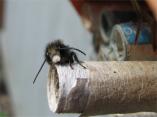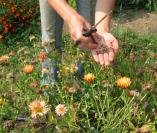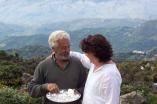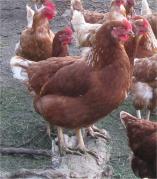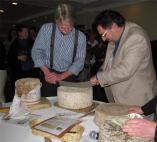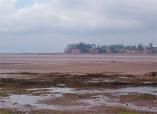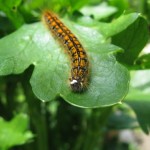I have been off-line for a while. In this space should have been some amusing tidbits from the Writers Union AGM which I unfortunately missed in its entirety due to what I am calling Italian influenza, since I received it from someone who brought it back with her from Rome.
I have passed the time of my recovery (and then some) picking tent caterpillars off my roses, blueberries and rhubarb. Not nearly enough of them have the tachinid fly larvae attached, but those that do seem to have two or three, which is hopeful, as the tachinids are helpful against caterpillars of many kinds, so I’m letting those afflicted eat their fill before they get the last headache of their lives.. and will be planting lots of tachinid-friendly plants like dill, parsley and Queen Anne’s Lace.
Meanwhile, BBC has been broadcasting Strands on its Book of the Week (sigh.. I remember when CBC used to have such offerings) by poet Jean Sprackland. In the second installment, she discusses the effects of anti-depressants on prawns. The excess fluoxetine excreted by Prozac users ends up in the ocean. It affects prawns by causing them to throw caution to the winds and swim towards the light… whereupon they become easy pickings for predators. This chemical also affects reproduction in mussels and has been found in fish near Montreal. Who knows, after that, how the fluoxetine travels through the food chain.
Add this to what we already know – the effects on fish of excreted birth control pill hormones, the drugs that we’re obliged to ingest through drinking water and produce grown in fields fertilized with sewage sludge – and to all we don’t yet know about the effects on other organisms.
In this anthropocentric world, we have invented a reality in which curing human ailments trumps any effect on other living beings. There are no legal checks on pharmaceutical companies to prove their products will not harm other species, or even humans who find them in their drinking water or vegetables down the line. Surely it’s long past time big pharma should be required to prove its products will not harm the rest of our ecosystem?
I have become a barley bore while plodding away these past few weeks on an article that will appear in a future issue of Small Farm Canada. I had a lot of great information I couldn’t include so here are some of my overflow facts that prove barley is the best thing ever:
- Our oldest grain, barley has been cultivated for around 10,000 years: it was found in Egyptian tombs and has a long and varied history, as a grain, a flour and a beer starter among others.
- It’s the grain highest in beta glucan, a soluble fibre which slows digestion of glucose, making it helpful for diabetics, and is getting attention for potential in fighting obesity and heart disease.
- In Nepal and Tibet tsampa (sampa) is a staple: toasted barley flour that is mixed with yak butter to make a nutritious (B vitamins, minerals and of course that all important beta glucan) bread or cake called pa. (A disheartening news item in the Nepali Times reports that tsampa is losing ground to instant noodles which are nutritionally bankrupt. The result of course is an increasingly malnourished population.)
- In parts of India, the beverage sattu is made of roasted barley, wheat/rice/chickpea flour, jaggery (raw sugar) and water. It’s quenching, nutritious and a long established fast food for travellers.
- In the British Isles, barley water is an old traditional drink whose benefits are said to include: clearing the complexion, preventing wrinkles, soothing the digestion, cleansing the kidneys, curing cystitis, treating atherosclerosis and preventing gallstones.
- In Italy, roasted barley is brewed as a coffee substitute: caffe orzo (not to be confused with the pasta)
- Roasted barley tea is called mugicha (麦茶?) in Japanese, dàmàichá (大麦茶) or màichá (麦茶 or 麥茶) in Mandarin Chinese, and boricha (보리차) in Korean.
- Barley has been studied for use in bioremediation:
- Bioremediation of coal bed methane product water
- Bioremediation of CCA-treated wood (using malted barley as a nutrient source for the metal-tolerant bacterium Bacillus licheniformis)
- Barley is a metallothionein (as are wheat, peas and soy): in animals they have been shown to bind copper, cadmium, zinc and silver and to detoxify normally lethal concentrations of cadmium and copper in yeast
- Barley is salt-tolerant and has been used to extract sodium chloride to reclaim sea water-flooded fields (it’s being studied as a way to remediate the tsunami-damaged farmland in Japan)
- Barley is thought to be an aluminum hyperaccumulator.
- Barley straw is a traditional treatment to prevent blue-green algae in ponds.
